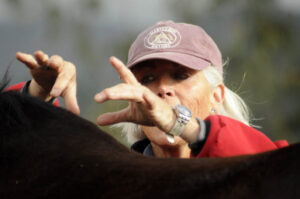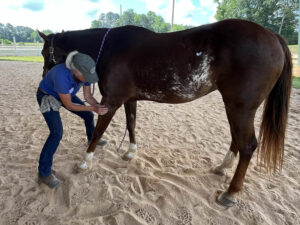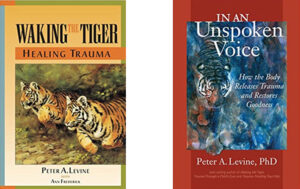Mirror in the Stall with Amber Lydic – Horses Body, Safety and Authenticity
Welcome back to The Mirror in the Stall, where we dive into the reflections our horses offer us and the deeper connections we can build when we truly listen. In this episode, I sit down with the amazing Sandy Vreeburg, a lead instructor and co-director of education at the Masterson Method.
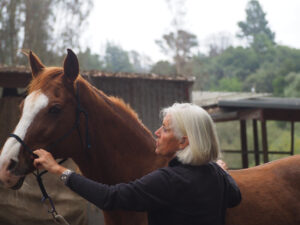 Sandy shares her journey into equine bodywork and the powerful ways this method supports not just a horse’s movement and performance, but their overall well-being—physically, emotionally, and even energetically.
Sandy shares her journey into equine bodywork and the powerful ways this method supports not just a horse’s movement and performance, but their overall well-being—physically, emotionally, and even energetically.
She walks us through how tuning into the horse’s nervous system can unlock deeper levels of safety, trust, and healing, reinforcing the idea that connection is the key to everything. We also talk about what it means to create a truly safe space—not just for our horses, but for ourselves.
Sandy gets real about the challenges of unlearning past practices and stepping into new ways of working with horses, where curiosity replaces pressure and presence becomes the most valuable tool.
She shares how this shift has not only changed the way she teaches but has also transformed her own life, offering her a deeper understanding of herself along the way. And of course, we explore the incredible ways horses mirror us back to ourselves.
From the way they respond to authenticity to the neurochemical shifts that happen when they feel safe, Sandy and I discuss how slowing down, paying attention, and truly being with our horses can change everything.
This conversation is for anyone looking to deepen their awareness, not just in their horsemanship but in life. So take a breath, settle in, and let’s explore what our horses are reflecting back to us today.
View the conversation here:
Find more about the Masterson Method https://mastersonmethod.com/
Previous episodes with Sandy:
Funny one:
Success Through Softening, Yielding, and Observing the Horse
Soften, yield, and observe the subtlest responses of the horse. These practices are the foundation of The Masterson Method®. There are layers and layers of subtleties built within those three foundational words. Fine-tuning them is imperative to be successful in your Masterson Method learning journey. These practices are the foundation of The Masterson Method®. There are layers and layers of subtleties built within those foundational words. Fine-tuning them is imperative to be successful in your Masterson Method learning journey.
The Laws of Softening It seems to me that many humans are unconscious in most of their actions throughout the day. The art of being successful with horses – be it as a trainer, rider, groom, volunteer horse handler or someone practicing bodywork – is intertwined with your awareness of your presence, meaning your breath, stance, and thoughts. Your breath should be smooth flowing and unrestricted, your stance should be relaxed (maybe relax a hip of your own as you look for your horse to relax his hip), and your thoughts should be quiet, calm, caring, present, and non-goal (or non-action) oriented.
One of Jim’s sayings is this: “When the horse braces, resists, or evades—soften, then ask again.” This means soften your hands, arms, shoulders, legs, and the rest of your body. Let go of your own tension. If you don’t, and you continue to ask or apply pressure, the horse will continue to brace, resist, or evade. These are among the Laws of Softening that you learn as you progress through coursework
Softening and Observation Another facet of softening comes from Observation, which influences how I approach the horse and how he responds to me. I like to enter the stall with a very soft eye and maintain that soft eye and quiet mind throughout my time with the horse. Before I enter the stall I stand at the door and speak softly to the horse and wait to see if he acknowledges me, steps towards me or further away, and possibly even faces the corner. After speaking with him and entering quietly with the halter and lead in my hands relaxed by my sides, I again wait to assess his comfort level. As I approach the horse I gently reach out and offer that they sniff my cupped hands. After their muzzle has investigated my hands they often feel “safe enough to be curious” to do a bit more research and then sniff my face. Once their curiosity is satisfied a deep breath ensues and I am ready to proceed, put the halter on, and begin the session. If I become too proactive in regard to wanting to get something done, I guarantee that my session will not be well received. Additionally, if I stare with a hard eye with too much focus on the horse’s body he will brace immediately and try to block me from having any communication with him. Adjusting your touch and movements when you observe the slightest hint that the horse is about to brace or move away from you will serve you well.
I have a few sayings that I use every time I teach and two of them are:
“The softer your eye, the more you see.”
“The softer your touch, the more you feel.”
The Art of Yielding. Jim guides us in the Art of Yielding in his bodywork courses. He gives great examples of mindfulness in regard to the pressure we use with our hand on a halter or lead rope or on the horse’s hip when gently asking him to yield his hindquarters and move over. I think that a key concept that helps all of us truly incorporate this practice of yielding is if we take into account that the horse leads from behind.
Lead horses position themselves behind the herd, and they gently push them ahead. When we ask a horse to move during a bodywork session—either to position both the horse and ourselves to a safer place or to guide the horse if he feels the need to move during the session—it is best that we do this with the gesture of leading from behind.
Here’s how this might look: the lead rope is loose enough for the horse to feel the freedom of his head and when the practitioner simply stands at the horse’s hip with the horse’s nose slightly tipped to the inside of the circle, the horse can have the freedom of moving his feet while staying in a nice close position to you. The horse feels safe and believes that you are trustworthy because you are guiding him with calm confidence in the same way that the leader of his or her herd would do.
The Subtleties of Intention. I believe that words paint pictures, and those pictures often ignite energy and actions in our body that are likely unseen to the casual observer, but not to the horse. While helping a student with a technique to release the muscles surrounding the shoulder, the student asked for guidance, and began her question with, “When you take the leg down and forward…?” I immediately rephrased the student’s question and answered saying that, “I never ‘take’ a leg anywhere. I ‘ask’ for the horse’s leg and then I’ll follow it out to where he can set it in a relaxed state.” That subtle rephrasing will very likely embed softness immediately into the student’s technique.
Another example of how Intention Matters is this. Recently, during an Advanced Course, a student very successfully calmed, and was then able to work beautifully with a young, athletic Warmblood who tends to take time to settle. I asked her how she was able to settle him so easily at the beginning of her session. Her response was, “I told him, ‘I just want to listen and hear what you have to say’.” I used that as a somatic example for the class, and had them compare the feeling in their body that they had when they visualize a caring friend say, “I just want to hear what you have to say,” versus “I just want to help you,” or “I just want to fix you.” Try this yourself now. Can you feel the difference in your breath and in your body, and then in your willingness to reveal your secrets when you compare those phrases? Just as the horse does when he feels safe enough to show us the part of his body that he’s been protecting.
Learning the Masterson Method ignited my passion for exploring the intricacies of the equine (and human) body through in-depth research. While I never questioned the efficacy of the work, I wanted to know more. One of my many Aha moments that quadrupled my zeal for the work that we do was when I first heard a licensed naturopath share her belief that, “the body needs to give license to heal.” That’s a perfect match for Jim’s principle in The Masterson Method that “we work with the horse, not to the horse, otherwise it doesn’t work.”
For the horse to give us license and for us to be successful, we need to soften, yield, and observe the subtle responses of the horse, just as Jim has taught us. When we do, the horse will relax and develop trust and connection with us because he knows we are seeing him and responding in a very caring way.
Sandy is an MMCP, Mentor, Coach, and Masterson Method Instructor. While she has always thrived on being productive,The Masterson Method® has taught Sandy to slow down, be in the moment and truly wait to see what the horse has to say. The responses of the horses that Sandy has worked on, and that of their owners, have been delightfully overwhelming
Adding Layers of Learning
While Peeling Away Layers of Tension: Recommend a Few Books for Equine Practitioners
First, I would like to invite you to go on a little “trail ride” with me where I will highlight some of the mentors who have helped me to put the “why” behind the effectiveness of our work as Masterson Method followers and Practitioners.
After becoming a certified Masterson Method Certified Practitioner (MMCP) in the fall of 2014, I felt an incredibly strong desire to know more about the horse. I wanted to see the horse from the inside out to better understand what might be going on in the horse’s body in regard to performance issues and patterns that I have come across as a practitioner. Keep in mind that I was never questioning the reality of the effectiveness of the Masterson Method as that had been proven to me time and time again from watching Jim’s demos and from the experiences that I received throughout the fieldwork program.
The first stop o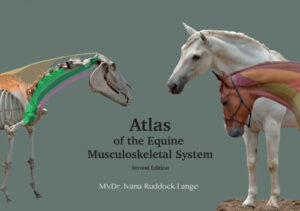 n my “trail ride” was taking a 3-day Whole Horse Dissection Course with Dr. Ivana Ruddock-Lange in October of 2014 (I have since taken 2 additional courses with her as the learning never stops and one with silver colored hair can only retain so much). Ivana may well know every muscle, its function, attachment and insertion, but her heartfelt emphasis of that course is to stress the importance of the fascia as well as the horse maintaining mobility and slide within this incredibly important connective tissue that surrounds every muscle, fills every cavity, and protects the organs.
n my “trail ride” was taking a 3-day Whole Horse Dissection Course with Dr. Ivana Ruddock-Lange in October of 2014 (I have since taken 2 additional courses with her as the learning never stops and one with silver colored hair can only retain so much). Ivana may well know every muscle, its function, attachment and insertion, but her heartfelt emphasis of that course is to stress the importance of the fascia as well as the horse maintaining mobility and slide within this incredibly important connective tissue that surrounds every muscle, fills every cavity, and protects the organs.
She was my first teacher who brought to my attention the revelations that horses are in fact attached tongue to tail, that they were not put on earth for us to ride (“ouch!”), and additionally stressed the importance of the soft touch of a skilled bodyworker. I now had a much better answer to why our educated touch while doing the Masterson Method techniques was so effective on an anatomical level. (I do want to add that I see many horses that feel and look good in their body, appreciate their work, and have an excellent relationship with their owner. I included the info above not to add pressure or guilt, per se, but to add mindfulness in this regard).
Second stop…now I wanted to know more about the horse’s biomechanics. How is he meant to move naturally, and while being ridden, especially as he moves up the potential training pyramid within a myriad of disciplines? Enter my mentors, Jillian Kreinbring and Dr. Gerd Heuschmann. I pursued an Applied Anatomy Course with Jillian and two Biomechanics courses and riding clinics with Dr. Heuschmann along with reading Gerd’s books titled “Tug of War, Balancing Act, and Collection or Contortion.”
Third stop…at this point I was eager to understand more about th e horse’s brain. Just how do they process information, and what are the similarities and differences in how the horse processes versus the human? Enter Dr. Steven Peters along with his book titled “Evidence Based Horsemanship” and his videos of the brain dissection (while working with Jim and Mark Rashid).
e horse’s brain. Just how do they process information, and what are the similarities and differences in how the horse processes versus the human? Enter Dr. Steven Peters along with his book titled “Evidence Based Horsemanship” and his videos of the brain dissection (while working with Jim and Mark Rashid).
The book is seemingly simplistic, but I picked up so many captivating pieces of information that were either new to me or helped confirm the “why” I was piecing together through observing certain patterns while working with young horses. I have watched Dr. Peters’ brain dissection video at least 4 times as I pick up more with each viewing. Dr. Peters, along with Maddy Butcher’s “Horse Head” helped to answer the “why” on how the horse processes information and additionally taught me more about the nervous systems where the horse can resid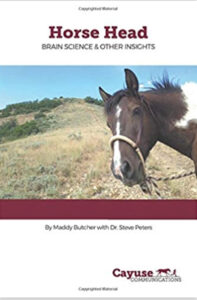 e and how our work as Masterson Method practitioners can facilitate the horse’s access to the oh so important Parasympathetic Nervous System.
e and how our work as Masterson Method practitioners can facilitate the horse’s access to the oh so important Parasympathetic Nervous System.
Fourth stop…by now I had been practicing the Masterson Method for over 5 years and had seen some great (and also some potentially dangerous) responses from horses during bodywork sessions. I had developed a reputation for being able to work with some very “difficult” rescue horses and/or OTTB’s. A few of the horses went from lowering their head, eyes closed and breathing deeply to standing up on their hind legs. In other words, after receiving only a few minutes of the Bladder Meridian, they had gone into a deep, serene state of the “rest and digest” Parasympathetic Nervous System and then snapped right out of that into the “fight or flight” Sympathetic Nervous System. I needed to know more.
It is clearly true that “adding movement to the soft tissue or junction of the horse releases tension and increases range of motion in the key areas that can affect performance,” as taught by our leader Jim Masterson. The work of Dr. Peter Levine and his books “Walking the Tiger and In an Unspoken Voice” build upon this and add a great deal of “why” I saw the actions described above and “why” I was often told that clients’ horses spooked less after a bodywork session. While Dr. Levine’s work centers around humans, his work further contributed a great deal to my understanding of Dr. Steven Peters’ work. Additionally, from him I learned the importance and very real fact that emotion resides in the body, and that releasing tension in an area while adding movement (somatics) can and will facilitate the release of emotional trauma. “Ohhhh boy!”
Fifth stop (and the impetus for sharing this list)…last Christmas, Jane Brown, a very close friend, former student and now MMCP colleague gave me the book titled “Sacred Spaces, Communion With the Horse Through Science and Spirit”, by Susan Fay, PhD. Jane clearly knows me very well. Upon finishing the book, I ran downstairs and immediately emailed Dr. Fay. I asked if she was aware of the Masterson Method and expressed how much her book resonated with me as an MMCP and felt that it would absolutely enhance the work of all Masterson “students” (be it fans, readers, viewers, enrolled students in the MMES program, fieldwork program and beyond!). I also asked if she would be open to doing a recorded interview with me that we could share in Jim’s newsletter.
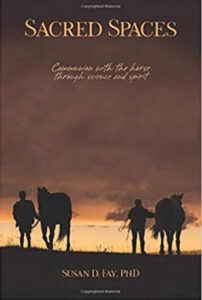 Dr. Fay readily agreed, and we set a date. Now, I needed to read the book again and highlight my questions and observations so that I could get the most out of the interview for all of us. Well, after 32 Post It’s, multiple paper-clipped pages, and 2 ½ legal pages of notes in numerical order, I was set for the call. However, the Colorado “snow Gods” did not oblige, and Susan was once again snowed in and without internet. We agreed to chat unrecorded on the phone, which ended up lasting over 2 hours! Susan is delightful, insightful, passionate and generous with her work.
Dr. Fay readily agreed, and we set a date. Now, I needed to read the book again and highlight my questions and observations so that I could get the most out of the interview for all of us. Well, after 32 Post It’s, multiple paper-clipped pages, and 2 ½ legal pages of notes in numerical order, I was set for the call. However, the Colorado “snow Gods” did not oblige, and Susan was once again snowed in and without internet. We agreed to chat unrecorded on the phone, which ended up lasting over 2 hours! Susan is delightful, insightful, passionate and generous with her work.
My notes started literally in the preface of the book where she highlights the idea that many people do not think that they are capable to reach the inner sanctum with the horse; they think that it takes superpowers and so forth. Dr. Fay expands on why Jim’s words are correct in regard to “anyone CAN learn this work if they WANT to,” “watch the horse…the horse will tell you,” along with “you have to be out of your mind to do this work”.
She puts the science behind energy fields, animal magnetism, the heart brain, the gut brain, and the proven value of mental imagery. Dr. Fay discusses “Attribution Bias” (we do this with horses and humans alike), “Fundamental Attribution Error,” and entraining to positive heart waves expanding on why horses are such good healers. She also brings renewed importance to correct breathing, both for us when around horses and for the horses themselves in regard to health and performance. Susan put the “why” horses can trust us and feel safe with us when we are congruent with our emotions and “why” we are drawn to be around them as well as being well received by these magnificent beings.
The learning never stops. How true are the words of Jim M…“watch the horse and the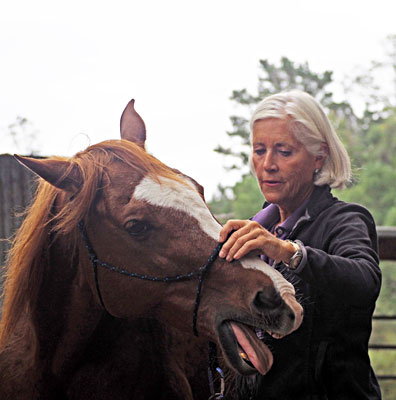 horse will tell you,” “soften,” and “allow the horse to move through the fidget, stay in the neighborhood, yet soften”. “Yes!” I’ll say that we are working with the horse’s nervous system when practicing the Masterson Method and it has been proven repeatedly that releasing tension in an area improves the range of motion and thereby the performance of the horse (one of the parameters of a clinical study according to Dr. Fay is that the results can be shown repeatedly).
horse will tell you,” “soften,” and “allow the horse to move through the fidget, stay in the neighborhood, yet soften”. “Yes!” I’ll say that we are working with the horse’s nervous system when practicing the Masterson Method and it has been proven repeatedly that releasing tension in an area improves the range of motion and thereby the performance of the horse (one of the parameters of a clinical study according to Dr. Fay is that the results can be shown repeatedly).
Now, just how many pictures of horses yawning does one need to see? And the real “money” in this for me is that this work develops trust in an incredibly forgiving being that is designed to flee when fearful, cares very much about how he fits into his herd , and was not put on this earth to ride.
How thankful I am for all of those who are passionate about making this world a safer, healthier and happier place for horses and for humans alike. Cheers to these incredible mentors (as well as the many unmentioned) for having the courage to put the “why” behind the sometimes “unprovable” or “woo woo” energy aspect of working with horses.
And cheers to you, Jim Masterson, for creating a method that is very teachable, incredibly effective, and makes all of us better humans for our horses.
The Body Doesn’t Lie (podcast)
Sandy Vreeburg saves the day!
Staying true to the horse
My business is growing by the day. The more horses that I work on, the more feeling and intuitive and capable I become. It is an incredible method, and while I am so happy that I have pursued the dissection courses as well as the biomechanics courses, I realize that Jim Masterson was right all along, “You don’t have to worry about being perfectly on a certain acupressure point for example, just watch the horse as the horse will tell you.” Staying inside the brace response and going lighter when you feel or see a reaction is key and it is what makes this technique so incredible.
Now not only am I a Mentor and a Coach , Jim recently made me an Instructor. And not only will I teach the 2-Day clinics that I host locally, I will teach all around California!
Timing is everything as I feel calm and confident and yet excited about it. I worked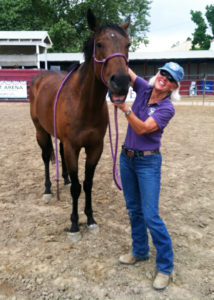 at the Western States Horse Expo with Jim in early June. I did two demos with him in front of the crowd as he did his clinics. A year ago my guts would have been in a knot about that. I worked with a rescued Mustang and a high-strung OTB. I just told myself to not think about the people and “stay true to the horse”. Well, they both figured out pretty quickly that they liked the work and calmed right down—heaven on earth.
at the Western States Horse Expo with Jim in early June. I did two demos with him in front of the crowd as he did his clinics. A year ago my guts would have been in a knot about that. I worked with a rescued Mustang and a high-strung OTB. I just told myself to not think about the people and “stay true to the horse”. Well, they both figured out pretty quickly that they liked the work and calmed right down—heaven on earth.
I am very happy that I have not pursued another technique to add to my toolbox as that would have kept me in my “head” and in the “trying to remember what I am supposed to do”. By staying so deep in the Masterson Method—and having now worked on several hundred horses—my fingertips, my eye, my experience along with my education, just keep becoming more fine tuned. I am all things Masterson, added to my lifetime of riding and loving and appreciating horses.
Masterson Method Hands-on Seminar at Moon Valley Ranch Watsonville CA
I am very excited to be assisting in this Masterson Method Hands-on Seminar! Check out the details below. Hope to see you there.
Masterson Method® Beyond Horse Massage
Equisance, Inc. at Moon Valley Ranch, Watsonville, CA
Weekend: July 9—10, 2016
The Masterson Method® Weekend Seminar-Workshop is the next practical step to take after reading/viewing the Beyond Horse Massage Book and DVD. In this “Hands-on” Weekend Seminar-Workshop, you will learn how to recognize what the horse is telling you through visual and palpable responses that enable you to get deeper releases of tension than the horse would otherwise be unable to release on its own. This is a truly interactive process that results in a change in relationship, and an improvement in movement and performance.
WHAT’S IN IT FOR YOU?
• Improved relationship and communication with your horse.
• Make your horse more relaxed and comfortable.
• Enable your horse to overcome limitations and restrictions that stand in the way of reaching his full potential.
Discover how much the Masterson Method® has to offer you and your horse by experiencing one of our hands-on weekend seminarworkshops for yourself!
Location
Equisance, Inc. at Moon Valley Ranch
345 Race Horse Lane
Watsonville, CA 95076
To Register:
www.mastersonmethod.com/wk-watsonville
Are Horses Really Made for Riding?
Each time I have taken the Whole Horse Dissection course taught by Ivana Ruddock there is an in depth and very emotional discussion about why horses were not made for riding. But rather than coming away distraught by the concept of curtailing this lifelong passion of mine, I instead vow to be the most educated and lightest rider that I can be and to be a steward to the horse by sharing what I have learned with every horse owner and rider that I know. While it is clear to me that they were not placed on this earth for our benefit, I do believe that we can provide great lives for our horses by riding with awareness and intelligence and by truly riding for the horse’s health and longevity. A trainer that I worked with years ago told me “to put brains in my fingertips”. I have never forgotten that statement and now through the education that I am pursuing as it relates to my efficacy as an Equine Bodyworker and a rider I have added to it to put brains in every part of my body as I ride my wonderful horse. Good riding as we know is an art, it is a lifelong journey to be the best that WE can be for our equine partners. I am honored and very thankful to have even taken a few steps on this path.
I came across a fascinating article on Horse Collaborative by Katja Bredlau-Morich
“The longtime rider in me says yes. After all, horses look like they are absolutely made for it; not too big and not too small; strong, agile with enough space on their back to carry a human, as they have done for centuries.
 “However, in addition to being a rider I am also an equine physical therapist, and in learning all about equine anatomy—bones, muscles, joints, tendons and ligaments—I have come to the conclusion that I do not believe horses are meant to be ridden.”
“However, in addition to being a rider I am also an equine physical therapist, and in learning all about equine anatomy—bones, muscles, joints, tendons and ligaments—I have come to the conclusion that I do not believe horses are meant to be ridden.”
She goes on with numerous examples and diagrams that support her ideas. She ends with:
“And still, I ride. I’m not ignoring all these anatomical facts I mentioned above. Not at all. I am very aware of it every time I get on my horse. I try to take these facts into consideration during and after riding to minimize any potential damage.
“The fact is, however, each time we ride, no matter how good of a rider we are, we will cause some micro-trauma to our horse. To keep this to a minimum, it is crucial to take good care of them. In my opinion, every horse that is ridden will benefit from bodywork, massage and physical therapy because being ridden is not their benefit.”
Want to become a better leader….learn from a horse
I thought you would enjoy this thought provoking article by Philippe Collard, President of Le Link, that I came across on Linkedin.
Certain things can be taught. Other things can only be learned. Such is “leadership” or the behavioral skills that we associate with leadership. As much as some “gurus” would have you believe, they are simply incapable to “teach” you leadership because it is something that can only be integrated in our own self through personal experiences, both positive and negative.
Thus you will read a lot of articles discussing what leaders are, what they are not, what they do and what they do not do. All these “gurus” can offer is something like “do this, be that way, do not do this and do not be that way”. It is an utterly pointless and usually very expensive curriculum.
 I once took the executive team of one of the companies I was turning around to a “leadership seminar” (I did not know better then). A very charismatic speaker discussed with great oratory skills about the “new leaders”. It lasted a couple of hours. We left with a huge binder full of “wisdom”, binders that collected dust in the office of those who had gotten them. A couple of weeks later, I went back to my team and asked: “What do you remember from that day and what have you applied in your daily life?” It was not a trick question because I had asked myself the question first and had found little for an answer. I wanted to find out if I was the “idiot” in the room. Nope. Nobody in the executive team was able to pinpoint some nugget of wisdom that they had not only taken away, but remembered and applied. I had just wasted a great deal of money.
I once took the executive team of one of the companies I was turning around to a “leadership seminar” (I did not know better then). A very charismatic speaker discussed with great oratory skills about the “new leaders”. It lasted a couple of hours. We left with a huge binder full of “wisdom”, binders that collected dust in the office of those who had gotten them. A couple of weeks later, I went back to my team and asked: “What do you remember from that day and what have you applied in your daily life?” It was not a trick question because I had asked myself the question first and had found little for an answer. I wanted to find out if I was the “idiot” in the room. Nope. Nobody in the executive team was able to pinpoint some nugget of wisdom that they had not only taken away, but remembered and applied. I had just wasted a great deal of money.
Later on, I discovered horses, riding and the tremendous amount of introspection that is required to be on a horse’s back asking that animal to do as you please, most often things that are completely unnatural to the horse. I slowly realize that the equestrian sport was teaching me a great deal more than just riding. I was learning about myself, my own tendencies, those that were conducive to harmonious riding and those that were absolutely destructive.
 One day it dawned on me. Riding was changing me. And I was carrying those changes with me wherever I went. At home. At work. I was able to recognize my faulty behaviors much quicker and was “trained”, so to speak, to correct them because of my riding. I thus came up with the idea of building a “program” (if you want to call it that) to allow people like me at the time (high-strung executives) to find their own self and learn a thing or two through interaction with horses. I called this program: EquiLead (www.equilead.ca).
One day it dawned on me. Riding was changing me. And I was carrying those changes with me wherever I went. At home. At work. I was able to recognize my faulty behaviors much quicker and was “trained”, so to speak, to correct them because of my riding. I thus came up with the idea of building a “program” (if you want to call it that) to allow people like me at the time (high-strung executives) to find their own self and learn a thing or two through interaction with horses. I called this program: EquiLead (www.equilead.ca).
It took me many years to articulate and structure the program. This is not an easy thing to do and I am not a teacher, though this is not about teaching, as I will emphasize later on. But eventually I did build the program and got people to go through it….entire article
Beyond Horse Massage Weekend Workshop July 11-12 Palo Alto
I am excited to be assisting in the Masterson Method Beyond Horse Massage Weekend Seminar-Workshop, July 11 through July 12 at the beautiful Stanford Stables in Palo Alto CA. It will be taught by Vanessa Helvy. I truly hope to see you there.
This great hands-on workshop is the place to learn how to recognize and use the visual responses of the horse to your touch to find and release accumulated stress in key junctions of the body that most affect performance. These techniques have been successfully taught to hundreds of owners, therapists and trainers worldwide, enabling them to open new levels of communication and relationship with their horses.
This short video is of Jim Masterson working on Hind End Release points. I selected it as an example because how often do we encounter our horse being a bit short-strided or just “not quite right” behind with no apparent problem in the feet or lower legs. The Master Method acknowledges that it could be the result of tension, strain or spasm in the deeper muscles of the hind end or the lower back. The video does start out with an ad, but it is worth waiting through for this great example.
In addition, as a life long learner I am continuing my education into all aspects of horses. I just finished the Whole Horse Dissection Clinic in Pennsylvania taught by Ivana Ruddock of Equine Touch.
Ivana is a veterinarian, pathologist, anatomist and equine body worker. Her class focuses on the fact that all muscles, joints, tendons and ligaments are connected to each other through the phenomenal living and thinking organism of fascia. In other words…our horses feel and are affected by “every little move we make”. For example a tight girth could actually pull on the stifle and affect the forward motion and sought-after length of that hind stride. Gets you thinking doesn’t it?!?!
I look forward to sharing some of the valuable and eye opening information that I learned from the course the next time we meet.


